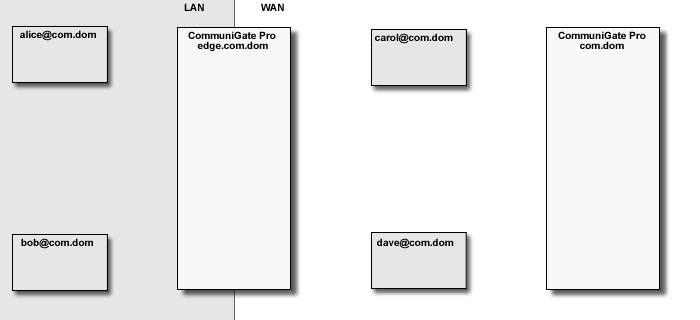
Signals |
|---|
| |||||||
|
 |
Version 5.1 |
|||||||||||||||||||||||||||||
|
|
The "basic" communication model assumes that endpoints can communicate directly, i.e. that all "elements", including clients - phones, softphones, PBX applications), and servers have "real" Internet IP Addresses. In this situation the Server is needed only to establish a call. Media data and (in case of SIP) in-call signalling requests are sent directly between the endpoints:

CommuniGate Pro supports automatic "NAT traversal" for the standard-based real-time communications.

The CommuniGate Pro SIP Module detects session re-INVITE requests as well as BYE requests and update and removes the session proxies accordingly. The time-out mechanism is used to remove "abandoned" media proxies.
The CommuniGate Pro provides NAT proxy services for:
Note: If you need the Media Stream Proxy functionality, make sure that the LAN and NAT data is specified correctly on the LAN IPs settings page.
Note: The Server automatically builds Media Stream Proxies when it relays requests from IPv4 addresses to IPv6 addresses and vice versa.

Note: modern SIP clients support various NAT traversal methods (STUN, etc.). Many of these implementations are quite buggy, so it is often more reliable to switch the client-side NAT traversal methods off, and rely on the CommuniGate Pro SIP Module far-end NAT traversal capabilities instead.
Note: due to the nature of the TCP protocol and the Firewall concept, it is not possible (in general) to open a TCP connection to a client behind a far-end NAT ("near-end" NAT configurations do not have this problem). This means that clients behind a far-end NAT cannot initiate TCP (T.120) sessions. To solve this problem, you may want to:

The CommuniGate Pro SIP Module detects "media loops", when a call placed from within LAN is proxied to WAN, and then proxied back to the same LAN. In this case the Media Proxies are removed, eliminating unnecessary overhead, and allowing SIP clients to communicate directly within one LAN, while proving registrar services outside that LAN.

The SIP module can detect much more complex loop cases, either avoiding Media Proxies altogether, or minimizing the number of Media Proxies used.